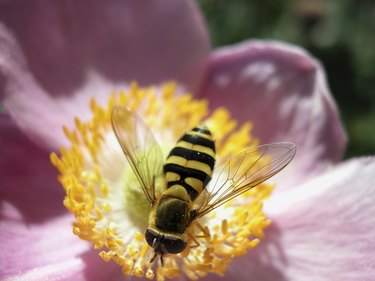 Bees rely on warm days to heat their muscles so they can fly. Image Credit: Ablestock.com/AbleStock.com/Getty Images
Bees rely on warm days to heat their muscles so they can fly. Image Credit: Ablestock.com/AbleStock.com/Getty Images
Bees are an intricate part of the pollination process. Honeybees account for more than 80 percent of the pollination that most vegetables, fruits and legumes need, the University of Minnesota Extension states on its website. Normally found on spring, summer and fall blossoms, bees use the nectar and pollen they collect for sustenance and hive warmth. In fact, freezing temperatures kill bees if they don't warm themselves within their hive.
Video of the Day
Cold-Blooded
Bees are cold-blooded; they rely on outside temperatures to regulate their body heat. As a result, honeybees typically emerge from their protective hives during the daytime, commonly between 8 a.m. and 5 p.m. They fly only when the air temperature is above 55 to 60 degrees Fahrenheit. Freezing temperatures essentially lock bee muscles in place; their wings cannot beat correctly for proper and safe flight. Being in dropping temperatures causes exposure and normally death. Freezing temperatures also effect nectar viscosity. Even if bees could fly in cold temperatures, flower nectar may be too thick for them to collect or the flowers may be closed in response to the weather.
Cold-Weather Hive Activity
A typical beehive maintains an interior temperature of about 91 to 95 degrees Fahrenheit. When freezing temperatures arrive, bees can survive only if they remain inside the hive in a large group, much like penguins huddling together during winter. Clustering, however, does not generate enough heat to combat death from freezing. Bees consume the honey reserves within the hive to create more heat. If bees leave the hive during a cold period, they usually freeze before returning.
Population Control
Bees use freezing temperatures to their advantage for hive population control. Specific bees, called drones, are used simply for reproduction; they allow the queen bee to create numerous eggs during the warm months. By autumn, the drones are not needed. Worker bees remove them from the hive. With cold weather setting in, exposed drones freeze, effectively controlling the hive's population. A hive may lose up to one-half of its population during winter months. This constant hive rejuvenation allows the queen to produce more worker bees for increased nectar and pollen collection.
Unwanted Hives
Your home may have structural cavities that bees find desirable for a hive. If you find a hive hidden in your home's walls, do not attempt to disturb it. Any vibration or disturbance to the colony easily agitates the bees, causing possible stings and major injury or death to humans with allergic reactions. Contact a professional bee removal company. It may be possible for the professionals to use freezing weather as a hive removal strategy. They can open the hive to the freezing elements. That process avoids the use of pesticides and ensures the safety of your home.



























